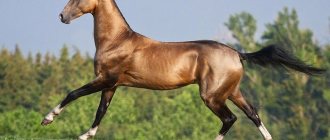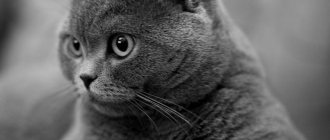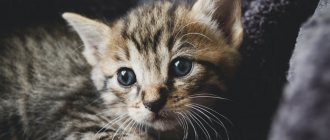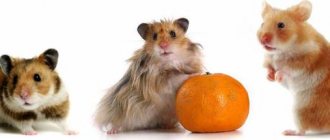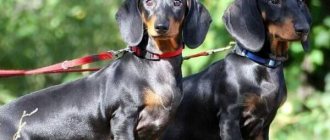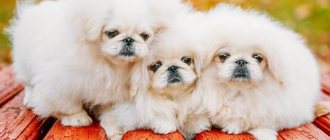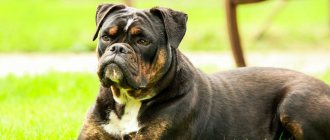Dachshunds are fearless hunters and lovely pets.
Whatever role this amazing dog plays, it will always be devoted to its owner, a brave protector, a cheerful friend, and a sweet prankster.
A dachshund can fill life with meaning and pleasure.
She understands only affection and persuasion, and is able to understand her owner at a glance and at a glance.
Violence will not achieve anything from her.
The dachshund was a favorite of many creative personalities, kings and emperors.
Origin story
Dachshunds are considered one of the oldest hunting breeds. Originally intended for badger hunting, the dog is a universal hunter - it can lead a trail and pull a wounded animal out of a swamp.
According to one version, the dachshund was bred in Germany in the 16th century from short hounds, had excellent working qualities and was in great demand, since its maintenance was inexpensive.
Another version speaks of the ancient Egyptian roots of the breed. In one of the Egyptian tombs, images of dachshund-like dogs with curved legs and a long body were found.
The world's first breed standard was adopted in 1870. , the 2001 standard of the International Canine Organization is in force for the Dachshund breed .
Classification by size
Spaniel: types of breed, what varieties there are
Standard Dachshund breed
The history of the breed began in the 16th century in Germany. Dogs have an elongated body and shorter legs. The boy's height is 22-27 cm, the girl's is 20-25 cm. The dog weighs up to 9 kg.
Dwarf
This species was also bred in Germany. When breeding, they wanted to change the size of the dog so that the pet could easily get a small animal from a hole. Optimal height for boys is 16-21 cm, for girls 14-19 cm. Dachshund weight up to 6 kg.
Rabbit dachshunds
A small dog from the presented breed, which was bred to hunt rabbits. Rabbit dachshunds have retained all the features of the dwarf species. Today she is used as a couch dog. Despite their size they are very hardy. The height of a boy's dachshund is 12-15 cm, a girl's is 10-13 cm.
Dachshund character
The dachshund is the bravest and most determined dog. Capable of thinking logically and calculating her actions several moves ahead. Dogs are extremely intelligent and know how to balance their own strengths with those of their opponents.
Of the hunting dogs, dachshunds are the least likely to die or be injured.
The animals are hardy, can chase prey for hours, wander through the forest with the hunter all day, exploring side paths along the way..
The independence of dachshunds can result in the dog’s reluctance to follow the owner’s commands and even escape from him.
Therefore, letting your pet off the leash on a walk in the forest, where her ineradicable hunting instinct may flare up, can only be done with complete confidence in her control.
Dachshunds are very active and playful, they care about everything . They tend to be dominant, so from an early age the dog must learn who is boss in the house.
Breed standard and photos
Ideal proportions for a dachshund:
- the distance from the ground to the bottom of the chest is 1/3 of the height at the withers;
- The length of the body relates to the height at the withers as 1.7-1.8:1.
- Chest circumference - 35 cm;
- Weight - 9 kg;
- The head is elongated with pronounced brow ridges;
- there is no sharp transition from forehead to nose;
- The muzzle is quite strong;
- The lips are not drooping and completely cover the teeth;
- Scissor bite;
- Full teeth;
- Almond-shaped eyes, brown, blue eyes are allowed in merle-colored dogs
- The ears are drooping, long but not excessively long, smooth, not folded with rounded, not pointed edges, close to the cheekbones.
- The neck is long and strong, carried freely
- The withers are well defined
- The back is strong, strong, straight or slightly sloping.
- The croup is wide, slightly sloping
- The chest is wide, the ribs are laid back. Ideally, the front leg, when viewed from the side, covers the lower point of the sternum. This is achieved by the correct length of the shoulder blade and shoulder and the appropriate angle between them.
- The stomach is slightly tucked.
- The coat is not too fine, not coarse, without any bald patches. By type of coat there are smooth-haired, long-haired and wire-haired
- in color - single-color (all shades of red-red, fawn. There may be one or another admixture of black wool); two-color (Black or brown with red tan); marble and brindle
The purebred dachshund is a squat dog with an elongated body and short, strong legs..
Distinguished by the proud carriage of the head with the attentive gaze of intelligent eyes. The dachshund should not appear too heavy or frail, like a weasel animal. Her movements, despite her short legs, are smooth and energetic.
Based on size, the breed is divided into three varieties:
- Standard.
- Miniature (dwarf).
- Rabbit.
The breed standard is valid for all types of dachshunds.
They differ only in size. All measurements are taken at least 15 months of age.
| Types of dachshunds | Bust | weight |
| standard | 35 cm | 9 kg |
| miniature | 30-35 cm | 4.5-6 kg |
| rabbit | 30 cm | 2.5-3 kg |
Smaller copies of the dachshund were bred in Germany at the end of the 19th century specifically for hunting small burrowing animals. The credit for the appearance of these varieties goes to Dr. Friedrich Engelmann.
Miniature dogs were obtained when small specimens of standard dachshunds began to be selected for breeding work . In 1905, there was already a club for fans of miniature dachshunds, which received its name of the same name.
Dwarf and rabbit dachshunds retain all the hunting qualities, habits and habits, character traits characteristic of standard dachshunds.
According to the type of coat, dachshunds are divided into::
- smooth-haired,
- long-haired,
- Wire-haired.
In a smooth-haired dachshund:
- the body is covered with short, thick hair without bald areas;
- on the tail the hair is sparser. May be elongated on the lower part of the tail.
In long-haired:
On top of the dog’s body, the fur fits tightly and lengthens downward. The fringe hangs beautifully on the ears.
- the back of the legs is decorated with fringes;
- the tail boasts the longest hair.
In the wire-haired:
- the wool is rough, wire-like. There is undercoat. The length of the hair on the entire body is the same. On the ears it becomes flattened and short. The variety is characterized by the presence of a beard and shaggy eyebrows;
- The tail is dressed evenly and tightly.
Breed characteristics
The pet is quite independent, but loves to communicate with its owner, gets along well with other pets, and does not require long, tedious brushing of its fur (the breed is short-haired). The dachshund has a distinctive appearance: there are no varieties of dogs that resemble this short pet with an elongated body, long ears, a sharp muzzle and a thin, elastic tail.
Dachshund breed standards:
| Parameter | Peculiarities |
| Appearance | Long body, short, strong legs, fairly long thin tail, sharp muzzle, floppy, long ears, dark eyes, feet slightly turned outward |
| Weight | Miniature dachshund – up to 5 kg, standard – from 7 to 15 kg |
| Height | No more than 35 cm |
| Lifespan | Up to 15 years in good conditions |
| Color | Red is the most popular. Other types of color: black, dark background with tan or apples, chocolate, cream |
| Height at withers | From 30 to 35 cm |
| Coat types | Wire-haired, smooth-haired, long-haired |
How does false pregnancy manifest in small breed dogs and does the animal need to be treated? Read useful information.
A description of the Chihuahua dog breed, features of keeping and feeding the pet can be seen in this article.
Character
Features of Dachshund behavior:
- very devoted to the owner;
- is wary of strangers;
- barks loudly at the slightest rustle or suspicious noise;
- sometimes displays some of the viciousness inherent in hunting dogs. For this reason, you should not get a burrowing dog in a family with children. The dachshund will not tolerate attempts to pull the tail, ears or lift the pet; it may bite the offender, but with great love from the owners, the dog becomes very affectionate.
Basic colors
Single color:
- red (the most valuable),
- brown (chocolate),
- all shades of red,
- pale yellow,
- sand.
White markings, small and in very limited quantities, are not a defect in the breed . But still the presence of white is not desirable.
Black color may be present in the color as a minor impurity. The nose and nails of dogs of the same color should preferably be black.
Two-color:
- black and tan,
- brown and tan.
Tan can be red, reddish-brown, fawn . Extensive scorch marks are not welcome.
Black dachshunds have nails and nose that match their color. In chocolate dogs, these exterior elements are possible in brown.
Marble
With a merle color, the main color is black, red or gray, on which small gray or beige spots are randomly scattered.
A predominance of light or dark color is not allowed.
Brindle
Red or fawn with darker stripes.
Photos of unusual dachshunds
- There are completely white dachshunds without a single spot of another color. Only her nose and claws remain black. Not recognized as a standard.
- Dachshunds with boar coloring. Recognized as a standard only for the wire-haired variety. In Russia, the boar color of smooth-haired individuals is not an obstacle to participation in exhibitions.
- White spotted dachshunds. Large, mostly dark spots of different colors are scattered throughout the main white color. The claws and nose remain black.
- Double marbled dachshunds. Large white spots are combined with smaller dark ones of different shades. Sometimes the spots completely cover the main color, sometimes there are only a few spots. This color may have red tan marks. The color is elegant, but such dogs can be blind or deaf from birth. Not recognized as a standard.
- Very rare sable color. The wool is colored unevenly. The fur at the root is lighter, and towards the end it is more richly colored. There may be some black on the ears and back.
What do boys and girls look like and how do they differ?
Boys and girls dachshunds differ in physiological characteristics . These differences will become clearly visible only by one and a half months, so you should not try to immediately determine the sex of newborn babies, making the mother and cubs nervous.
NOTE!
Starting from six months, male dogs already mark their territory; a female dachshund goes through her first heat at eight months.
Males are larger and more muscular than females. Whether gender influences behavior is difficult to say.
There are both aggressive females and docile males.
Character traits are more likely to be shaped by upbringing and genetics..
Appearance of puppies
Puppies are usually taken from kennels at two months of age . The baby should be compact, dense, but not fat. At this time, small dachshunds already have a squat appearance, and the back should be flat, not sagging and not have humps.
The paws should not be too thin . The two-month-old puppy moves freely and energetically. Grown-up dachshund cubs already have a meaningful, focused gaze.
Eyes - brown, blue (in whole or in part) are allowed only in marbled varieties.
The color of puppies is darker and more saturated than that of adult dogs, so a bright contrast between the base color and tan in two-color dogs is preferable, because over time the color will lighten.
It is better that the puppy does not have white markings . If the puppy has a completely black color without tan, this is a sign of impure breeding.
The puppy's claws and nose are black. Only chocolate ones can be brown.
Smooth-haired dachshund: general appearance and color
The smooth-haired dachshund is a short dog with an elongated but strong build, short legs, and strong and dense muscles. According to the standard, any coat color is allowed, with the exception of white; only a small light spot on the chest is possible. The claws and nose are black. Some relaxations are allowed, but they are still undesirable. Red dachshunds may have red lobes, while chocolate ones may have brown or flesh-colored lobes. In representatives with merle coloration, the spots should be evenly distributed over the body and not be too large.
The weight of representatives of this species should be no more than 11.3 kg for males and no more than 10.4 kg for females.
The smooth-haired dachshund is, first and foremost, a hunting dog that perfectly adapts to any weather conditions. Its coat is dense and smooth, impervious to moisture and dirt.
How to choose a pet
- First of all, make sure that the nursery or breeder has a decent reputation.
- Study breed standards.
- Get acquainted with the pedigree of the parents.
- See the puppy's mother. There is a high probability that the puppy will be a repeat of her.
- A purebred puppy will definitely have a personal card and a veterinary passport with information about its vaccination. He will have a mark on his right ear or stomach.
- Take a closer look at the behavior of the puppy in the nest. A small dachshund should be moderately active, playful, and inquisitive.
- If a dog is adopted for hunting, it would be good if the parents were workers.
The choice of dachshund coat type depends on personal preference . But a long-haired dog will be more difficult to care for.
If a smooth-haired dachshund only needs to be wiped with a suede glove or a terry towel, then a long-haired individual will require more thorough procedures.
This includes combing and cleaning after a walk (long hair will get more dirty). Shedding in smooth-haired dogs is also easier and not as intense as in long-haired dogs.
But all the trouble will be paid off with pride in a beautiful pet at the exhibition. Or just on a walk.
You can choose any type of dachshund . The main thing is to enjoy communicating with the dog. Having a dog in the house is not only a pleasure, but also a lot of work and responsibility.
Dachshunds are not only highly intelligent, but also cunning . The owner will raise the pet, and the pet will still think about whether to give in to him or not.
The dog's hair is coming out - what to do?
When alopecia appears, it is recommended not to self-medicate - if a dog has hair loss, it is not the symptoms that need to be eliminated, but the causes of the disease. The dachshund needs to be shown to an experienced veterinarian and undergo the necessary tests for an accurate diagnosis. Treatment will depend entirely on the causes of baldness.
Hormonal drugs are prescribed extremely rarely, because such treatment is very expensive. An effective remedy is to take antibiotics, strengthen the dog’s immunity, eat vitamin supplements, and also create a special diet depending on the lack or excess of certain substances in the body. In case of infection with worms, deworming is necessary.
In general, it is never superfluous to take extra care of the coat - using mild shampoos, drying without using a hair dryer and regular brushing with special brushes. In most cases, hair loss can be stopped, even if the dog has a lot of hair. What to do next to restore the coat is a separate question. Most often, a comprehensive intake of vitamins and improving the living conditions of the pet is sufficient.
Those who like to dress their dog in various overalls are recommended to do this only in bad weather, because with limited access to oxygen, the condition of the coat and skin worsens. The appearance of bald areas on a dog’s body should not be ignored. The mistake of many owners is to react late when the dog’s hair is growing too much. In this case, it will be more difficult to treat the disease.
Any four-legged friend is uncomfortable with itching and flaking of the skin, so it is the responsibility of every responsible owner to take care of the condition of their pet’s coat and skin. A dachshund with thick and strong hair is pleasant to caress, pick up and play with.

